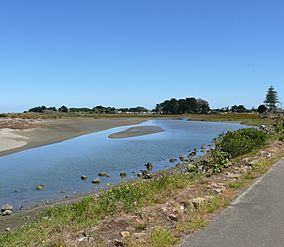Manawatu Estuary facts for kids
Quick facts for kids Manawatu river mouth and estuary |
|
|---|---|

Manawatu Estuary at Foxton Beach
|
|
| Location | North Island, New Zealand |
| Nearest city | Foxton Beach |
| Area | 200 hectares (490 acres) |
| Official name: Manawatu river mouth and estuary | |
| Designated: | 25 July 2005 |
| Reference #: | 1491 |
The Manawatu Estuary is a very special place in New Zealand, located where the Manawatu River flows into the sea near Foxton Beach on the lower North Island. It's a type of wetland that is known around the world for its importance. This estuary is one of only a few places in New Zealand that has been given a special title called a Ramsar site.
At about 250 hectares (which is like 250 rugby fields!), the Manawatu Estuary is the biggest estuary in the lower North Island. It's a busy home for many different kinds of birds. In fact, people have seen 93 different bird species here!
Contents
What is an Estuary?
An estuary is a unique body of water where fresh water from a river mixes with salty water from the ocean. This creates a special environment that is different from both a river and the open sea. Estuaries are often called "nurseries of the sea" because many young fish and other creatures grow up there.
Why are Estuaries Important?
Estuaries are super important for many reasons:
- Homes for Wildlife: They provide food, shelter, and breeding grounds for many animals, especially birds, fish, and shellfish.
- Natural Filters: They help clean the water by trapping pollution and sediments before they reach the ocean.
- Protecting the Coast: Estuaries can help protect coastal areas from storms and floods by absorbing extra water.
- Food Source: Many of the fish and shellfish we eat spend part of their lives in estuaries.
A Ramsar Site: International Recognition
The Manawatu Estuary became a Ramsar site in 2005. This means it's recognized as a wetland of international importance.
What is a Ramsar Site?
The Ramsar Convention is an international agreement that helps protect wetlands around the world. It was signed in 1971 in Ramsar, Iran. When a wetland becomes a Ramsar site, it means that countries have agreed to protect and wisely use that wetland because it's so important for nature and people. The Manawatu Estuary earned this title because it's a vital home for many birds, especially those that travel long distances.
Birds of the Estuary
The Manawatu Estuary is a birdwatcher's paradise! With 93 different bird species recorded, it's clear why this place is so special for our feathered friends. The mix of fresh and salt water, along with the muddy flats and plants, creates the perfect feeding and resting spot.
Migratory Birds
Every year, during spring, many amazing birds arrive at the estuary after flying thousands of kilometers. They come here for the summer to feed and rest before heading back to their colder homes. Some of these incredible travelers include:
- Bar-tailed Godwit: These birds are famous for making one of the longest non-stop flights of any bird! They fly all the way from Alaska to New Zealand.
- Red Knot: Another long-distance champion, red knots also travel from the Arctic to spend their summer in New Zealand.
- Pacific Golden Plover: These beautiful birds fly from places like Alaska and Siberia.
- Japanese Snipe: These shy birds come from Japan and eastern Asia.
- Wandering Tattler: As their name suggests, these birds wander widely across the Pacific Ocean.
- Whimbrel: These birds, with their long, curved beaks, also travel from the northern parts of the world.
These birds rely on places like the Manawatu Estuary to refuel and rest during their incredible journeys.
Protecting the Estuary
Because the Manawatu Estuary is so important for birds and the environment, it's crucial to protect it. Efforts are made to keep the estuary healthy by managing pollution, protecting the habitats, and educating people about its value. By looking after this special wetland, we can ensure that future generations can also enjoy its beauty and that the amazing migratory birds continue to have a safe place to visit.

